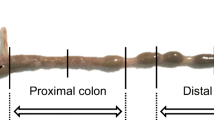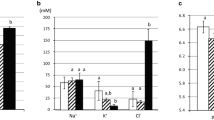Abstract
Bile acids play important physiological role in the solubilisation and absorption of dietary lipids. However, under pathophysiological conditions, such as short bowel syndrome, they can reach the colon in high concentrations inducing diarrhoea. In this study, our aim was to characterise the cellular pathomechanism of bile-induced diarrhoea using human samples. Colonic crypts were isolated from biopsies of patients (controls with negative colonoscopic findings) and of cholecystectomised/ileum-resected patients with or without diarrhoea. In vitro measurement of the transporter activities revealed impaired Na+/H+ exchanger (NHE) and Cl−/HCO3 − exchanger (CBE) activities in cholecystectomised/ileum-resected patients suffering from diarrhoea, compared to control patients. Acute treatment of colonic crypts with 0.3 mM chenodeoxycholate caused dose-dependent intracellular acidosis; moreover, the activities of acid/base transporters (NHE and CBE) were strongly impaired. This concentration of chenodeoxycholate did not cause morphological changes in colonic epithelial cells, although significantly reduced the intracellular ATP level, decreased mitochondrial transmembrane potential and caused sustained intracellular Ca2+ elevation. We also showed that chenodeoxycholate induced Ca2+ release from the endoplasmic reticulum and extracellular Ca2+ influx contributing to the Ca2+ elevation. Importantly, our results suggest that the chenodeoxycholate-induced inhibition of NHE activities was ATP-dependent, whereas the inhibition of CBE activity was mediated by the sustained Ca2+ elevation. We suggest that bile acids inhibit the function of ion transporters via cellular energy breakdown and Ca2+ overload in human colonic epithelial cells, which can reduce fluid and electrolyte absorption in the colon and promote the development of diarrhoea.








Similar content being viewed by others
Abbreviations
- BA:
-
Bile acids
- BAM:
-
Bile acid malabsorption
- BAPTA-AM:
-
1,2-Bis(o-aminophenoxy)ethane-N,N,N′,N′-tetraacetic acid
- [Ca2+]i :
-
Intracellular Ca2+ concentration
- CBE:
-
Cl−/HCO3 − exchanger
- CCCP:
-
Carbonyl cyanide m-chlorophenyl hydrazone
- CDC:
-
Chenodeoxycholate
- ER:
-
Endoplasmic reticulum
- GCDC:
-
Glycochenodeoxycholate
- H2DIDS:
-
Dihydro-4,4′-diisothiocyanostilbene-2,2′-disulphonic acid
- HOE-642:
-
4-Isopropyl-3-methylsulphonylbenzoyl-guanidin methanesulphonate
- IP3R:
-
Inositol-triphosphate receptor
- (ΔΨ)m :
-
Mitochondrial transmembrane potential
- NHE:
-
Na+/H+ exchanger
- pHi :
-
Intracellular pH
- RR:
-
Ruthenium red
- RyR:
-
Ryanodin receptor
- SERCA:
-
Sarcoplasmic/endoplasmic reticulum calcium ATPase
- SLC26:
-
Solute carrier family 26
- TEM:
-
Transmission electron microscopy
- Tg:
-
Thapsigargin
References
Arlow FL, Dekovich AA, Priest RJ, Beher WT (1987) Bile acid-mediated postcholecystectomy diarrhea. Arch Intern Med 147(7):1327–1329
Bachmann O, Riederer B, Rossmann H, Groos S, Schultheis PJ, Shull GE, Gregor M, Manns MP, Seidler U (2004) The Na+/H+ exchanger isoform 2 is the predominant NHE isoform in murine colonic crypts and its lack causes NHE3 upregulation. Am J Physiol Gastrointest Liver Physiol 287(1):G125–G133
Borghede MK, Schlutter JM, Agnholt JS, Christensen LA, Gormsen LC, Dahlerup JF (2011) Bile acid malabsorption investigated by selenium-75-homocholic acid taurine ((75)SeHCAT) scans: causes and treatment responses to cholestyramine in 298 patients with chronic watery diarrhoea. Eur J Int Med 22(6):e137–e140
Byrne AM, Foran E, Sharma R, Davies A, Mahon C, O'Sullivan J, O’Donoghue D, Kelleher D (2010) Long A bile acids modulate the Golgi membrane fission process via a protein kinase Ceta and protein kinase D-dependent pathway in colonic epithelial cells. Carcinogenesis 31(4):737–744
Cabado AG, Yu FH, Kapus A, Lukacs G, Grinstein S, Orlowski J (1996) Distinct structural domains confer cAMP sensitivity and ATP dependence to the Na+/H+ exchanger NHE3 isoform. J Biol Chem 271(7):3590–3599
Cinar A, Chen M, Riederer B, Bachmann O, Wiemann M, Manns M, Kocher O, Seidler U (2007) NHE3 inhibition by cAMP and Ca2+ is abolished in PDZ-domain protein PDZK1-deficient murine enterocytes. J Physiol 581(Pt 3):1235–1246
Criddle DN, Murphy J, Fistetto G, Barrow S, Tepikin AV, Neoptolemos JP, Sutton R, Petersen OH (2006) Fatty acid ethyl esters cause pancreatic calcium toxicity via inositol trisphosphate receptors and loss of ATP synthesis. Gastroenterology 130(3):781–793
Farkas K, Yeruva S, Rakonczay Z Jr, Ludolph L, Molnar T, Nagy F, Szepes Z, Schnur A, Wittmann T, Hubricht J, Riederer B, Venglovecz V, Lazar G, Kiraly M, Zsembery A, Varga G, Seidler U, Hegyi P (2011) New therapeutic targets in ulcerative colitis: the importance of ion transporters in the human colon. Inflamm Bowel Dis 17(4):884–898
Ford GA, Preece JD, Davies IH, Wilkinson SP (1992) Use of the SeHCAT test in the investigation of diarrhoea. Postgrad Med J 68(798):272–276
Fromm H, Malavolti M (1986) Bile acid-induced diarrhoea. Clin Gastroenterol 15(3):567–582
Gawenis LR, Stien X, Shull GE, Schultheis PJ, Woo AL, Walker NM, Clarke LL (2002) Intestinal NaCl transport in NHE2 and NHE3 knockout mice. Am J Physiol Gastrointest Liver Physiol 282(5):G776–G784
Gerasimenko JV, Flowerdew SE, Voronina SG, Sukhomlin TK, Tepikin AV, Petersen OH, Gerasimenko OV (2006) Bile acids induce Ca2+ release from both the endoplasmic reticulum and acidic intracellular calcium stores through activation of inositol trisphosphate receptors and ryanodine receptors. J Biol Chem 281(52):40154–40163
Gerasimenko JV, Sherwood M, Tepikin AV, Petersen OH, Gerasimenko OV (2006) NAADP, cADPR and IP3 all release Ca2+ from the endoplasmic reticulum and an acidic store in the secretory granule area. J Cell Sci 119(Pt 2):226–238
Hamilton JP, Xie G, Raufman JP, Hogan S, Griffin TL, Packard CA, Chatfield DA, Hagey LR, Steinbach JH, Hofmann AF (2007) Human cecal bile acids: concentration and spectrum. Am J Physiol Gastrointest Liver Physiol 293(1):G256–G263
Hegyi P, Gray MA, Argent BE (2003) Substance P inhibits bicarbonate secretion from guinea pig pancreatic ducts by modulating an anion exchanger. Am J Physiol Cell Physiol 285(2):C268–C276
Hegyi P, Rakonczay Z Jr, Gray MA, Argent BE (2004) Measurement of intracellular pH in pancreatic duct cells: a new method for calibrating the fluorescence data. Pancreas 28(4):427–434
Hofmann AF (2009) The enterohepatic circulation of bile acids in mammals: form and functions. Front Biosci (Landmark Ed) 14:2584–2598
Hoglund P, Haila S, Scherer SW, Tsui LC, Green ED, Weissenbach J, Holmberg C, de la Chapelle A, Kere J (1996) Positional candidate genes for congenital chloride diarrhea suggested by high-resolution physical mapping in chromosome region 7q31. Genome Res 6(3):202–210
Hoogerwerf WA, Tsao SC, Devuyst O, Levine SA, Yun CH, Yip JW, Cohen ME, Wilson PD, Lazenby AJ, Tse CM, Donowitz M (1996) NHE2 and NHE3 are human and rabbit intestinal brush-border proteins. Am J Physiol 270(1 Pt 1):G29–G41
Hylemon PB, Zhou H, Pandak WM, Ren S, Gil G, Dent P (2009) Bile acids as regulatory molecules. J Lipid Res 50(8):1509–1520
Inoue M, Fujishiro N, Imanaga I, Sakamoto Y (2002) Role of ATP decrease in secretion induced by mitochondrial dysfunction in guinea-pig adrenal chromaffin cells. J Physiol 539(Pt 1):145–155
Keely SJ (2010) Missing link identified: GpBAR1 is a neuronal bile acid receptor. Neurogastroenterol Motil 22(7):711–717
Kiela PR, Xu H, Ghishan FK (2006) Apical Na+/H + exchangers in the mammalian gastrointestinal tract. J Physiol Pharmacol 57(Suppl 7):51–79
Kunzelmann K, Mall M (2002) Electrolyte transport in the mammalian colon: mechanisms and implications for disease. Physiol Rev 82(1):245–289
Lamprecht G, Hsieh CJ, Lissner S, Nold L, Heil A, Gaco V, Schafer J, Turner JR, Gregor M (2009) Intestinal anion exchanger down-regulated in adenoma (DRA) is inhibited by intracellular calcium. J Biol Chem 284(29):19744–19753
Leyssens A, Nowicky AV, Patterson L, Crompton M, Duchen MR (1996) The relationship between mitochondrial state, ATP hydrolysis, [Mg2+]i and [Ca2+]i studied in isolated rat cardiomyocytes. J Physiol 496(Pt 1):111–128
Makela S, Kere J, Holmberg C, Hoglund P (2002) SLC26A3 mutations in congenital chloride diarrhea. Hum Mutat 20(6):425–438
Maleth J, Venglovecz V, Razga Z, Tiszlavicz L, Rakonczay Z Jr, Hegyi P (2011) Non-conjugated chenodeoxycholate induces severe mitochondrial damage and inhibits bicarbonate transport in pancreatic duct cells. Gut 60(1):136–138
Musch MW, Arvans DL, Wu GD, Chang EB (2009) Functional coupling of the downregulated in adenoma Cl-/base exchanger DRA and the apical Na+/H + exchangers NHE2 and NHE3. Am J Physiol Gastrointest Liver Physiol 296(2):G202–G210
Payne CM, Crowley-Weber CL, Dvorak K, Bernstein C, Bernstein H, Holubec H, Crowley C, Garewal H (2005) Mitochondrial perturbation attenuates bile acid-induced cytotoxicity. Cell Biol Toxicol 21(5–6):215–231
Petersen OH, Tepikin AV (2008) Polarized calcium signaling in exocrine gland cells. Annu Rev Physiol 70:273–299
Philipp B (2011) Bacterial degradation of bile salts. Appl Microbiol Biotechnol 89(4):903–915
Rossel P, Sortsoe Jensen H, Qvist P, Arveschoug A (1999) Prognosis of adult-onset idiopathic bile acid malabsorption. Scand J Gastroenterol 34(6):587–590
Schultheis PJ, Clarke LL, Meneton P, Miller ML, Soleimani M, Gawenis LR, Riddle TM, Duffy JJ, Doetschman T, Wang T, Giebisch G, Aronson PS, Lorenz JN, Shull GE (1998) Renal and intestinal absorptive defects in mice lacking the NHE3 Na+/H+ exchanger. Nat Genet 19(3):282–285
Schweinfest CW, Spyropoulos DD, Henderson KW, Kim JH, Chapman JM, Barone S, Worrell RT, Wang Z, Soleimani M (2006) slc26a3 (dra)-deficient mice display chloride-losing diarrhea, enhanced colonic proliferation, and distinct up-regulation of ion transporters in the colon. J Biol Chem 281(49):37962–37971
Sciarretta G, Furno A, Mazzoni M, Malaguti P (1992) Post-cholecystectomy diarrhea: evidence of bile acid malabsorption assessed by SeHCAT test. Am J Gastroenterol 87(12):1852–1854
Shimada-Shimizu N, Hisamitsu T, Nakamura TY, Wakabayashi S (2013) Evidence that Na+/H+ exchanger 1 is an ATP-binding protein. Febs J 280(6):1430–1442
Shiue H, Musch MW, Wang Y, Chang EB, Turner JR (2005) Akt2 phosphorylates ezrin to trigger NHE3 translocation and activation. J Biol Chem 280(2):1688–1695
Smith MJ, Cherian P, Raju GS, Dawson BF, Mahon S, Bardhan KD (2000) Bile acid malabsorption in persistent diarrhoea. J R Coll Physicians Lond 34(5):448–451
Surawicz CM (2010) Mechanisms of diarrhea. Curr Gastroenterol Rep 12(4):236–241
Thomas JA, Buchsbaum RN, Zimniak A, Racker E (1979) Intracellular pH measurements in Ehrlich ascites tumor cells utilizing spectroscopic probes generated in situ. Biochemistry 18(11):2210–2218
Venglovecz V, Rakonczay Z Jr, Ozsvari B, Takacs T, Lonovics J, Varro A, Gray MA, Argent BE, Hegyi P (2008) Effects of bile acids on pancreatic ductal bicarbonate secretion in guinea pig. Gut 57(8):1102–1112
Voronina SG, Barrow SL, Gerasimenko OV, Petersen OH, Tepikin AV (2004) Effects of secretagogues and bile acids on mitochondrial membrane potential of pancreatic acinar cells: comparison of different modes of evaluating DeltaPsim. J Biol Chem 279(26):27327–27338
Walker NM, Simpson JE, Yen PF, Gill RK, Rigsby EV, Brazill JM, Dudeja PK, Schweinfest CW, Clarke LL (2008) Down-regulated in adenoma Cl-/HCO3 - exchanger couples with Na/H exchanger 3 for NaCl absorption in murine small intestine. Gastroenterology 135(5):1645–653 e1643
Walters JR, Pattni SS (2010) Managing bile acid diarrhoea. Ther Adv Gastroenterol 3(6):349–357
Weintraub WH, Machen TE (1989) pH regulation in hepatoma cells: roles for Na-H exchange, Cl-HCO3 exchange, and Na-HCO3 cotransport. Am J Physiol 257(3 Pt 1):G317–G327
Wilcox C, Turner J, Green J (2014) Systematic review: the management of chronic diarrhoea due to bile acid malabsorption. Aliment Pharmacol Ther 39(9):923–939. doi:10.1111/apt.12684
Xu H, Zhang B, Li J, Wang C, Chen H, Ghishan FK (2012) Impaired mucin synthesis and bicarbonate secretion in the colon of NHE8 knockout mice. Am J Physiol Gastrointest Liver Physiol 303(3):G335–G343
Yeruva S, Farkas K, Hubricht J, Rode K, Riederer B, Bachmann O, Cinar A, Rakonczay Z, Molnar T, Nagy F, Wedemeyer J, Manns M, Raddatz D, Musch MW, Chang EB, Hegyi P, Seidler U (2010) Preserved Na(+)/H(+) exchanger isoform 3 expression and localization, but decreased NHE3 function indicate regulatory sodium transport defect in ulcerative colitis. Inflamm Bowel Dis 16(7):1149–1161
Grant support
Our research is supported by Hungarian National Development Agency grants (TÁMOP-4.2.2.A-11/1/KONV-2012-0035, TÁMOP-4.2.2-A-11/1/KONV-2012-0052, TÁMOP-4.2.2.A-11/1/KONV-2012-0073), the Hungarian Scientific Research Fund (OTKA NF105758, NF100677, K109756, PD105948) and the Hungarian Academy of Sciences (BO/00531/11/5, BO/00632/14/5). This research was also supported by the European Union and the State of Hungary, co-financed by the European Social Fund in the framework of TÁMOP 4.2.4.A/2-11-1-2012-0001 and TÁMOP-4.2.4.A2- 710-SZJÖ-TOK-13-0017 ‘National Excellence Program’ and MTA-SZTE Momentum Grant (LP2014-10/2014).
Author information
Authors and Affiliations
Corresponding author
Rights and permissions
About this article
Cite this article
Pallagi-Kunstár, É., Farkas, K., Maléth, J. et al. Bile acids inhibit Na+/H+ exchanger and Cl−/HCO3 − exchanger activities via cellular energy breakdown and Ca2+ overload in human colonic crypts. Pflugers Arch - Eur J Physiol 467, 1277–1290 (2015). https://doi.org/10.1007/s00424-014-1560-9
Received:
Accepted:
Published:
Issue Date:
DOI: https://doi.org/10.1007/s00424-014-1560-9




